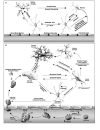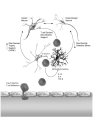Neuroinflammation, Oxidative Stress and the Pathogenesis of Parkinson's Disease
- PMID: 18060039
- PMCID: PMC1831679
- DOI: 10.1016/j.cnr.2006.09.006
Neuroinflammation, Oxidative Stress and the Pathogenesis of Parkinson's Disease
Abstract
Neuroinflammatory processes play a significant role in the pathogenesis of Parkinson's disease (PD). Epidemiologic, animal, human, and therapeutic studies all support the presence of an neuroinflammatory cascade in disease. This is highlighted by the neurotoxic potential of microglia . In steady state, microglia serve to protect the nervous system by acting as debris scavengers, killers of microbial pathogens, and regulators of innate and adaptive immune responses. In neurodegenerative diseases, activated microglia affect neuronal injury and death through production of glutamate, pro-inflammatory factors, reactive oxygen species, quinolinic acid amongst others and by mobilization of adaptive immune responses and cell chemotaxis leading to transendothelial migration of immunocytes across the blood-brain barrier and perpetuation of neural damage. As disease progresses, inflammatory secretions engage neighboring glial cells, including astrocytes and endothelial cells, resulting in a vicious cycle of autocrine and paracrine amplification of inflammation perpetuating tissue injury. Such pathogenic processes contribute to neurodegeneration in PD. Research from others and our own laboratories seek to harness such inflammatory processes with the singular goal of developing therapeutic interventions that positively affect the tempo and progression of human disease.
Figures




References
-
- Mayeux R. Epidemiology of neurodegeneration. Annu Rev Neurosci. 2003;26:81–104. - PubMed
-
- Fahn S, Przedborski S. Parkinsonism. In: Rowland LP, editor. Merritt's Neurology. Lippincott Williams & Wilkins; New York: 2000. pp. 679–693.
-
- Hornykiewicz O, Kish SJ. Biochemical pathophysiology of Parkinson's disease. Adv Neurol. 1987;45:19–34. - PubMed
-
- Clarke G, Collins RA, Leavitt BR, Andrews DF, Hayden MR, Lumsden CJ, et al. A onehit model of cell death in inherited neuronal degenerations. Nature. 2000;406:195–9. - PubMed
Grants and funding
LinkOut - more resources
Full Text Sources
Other Literature Sources
Research Materials
